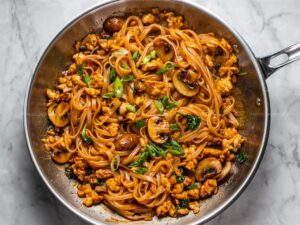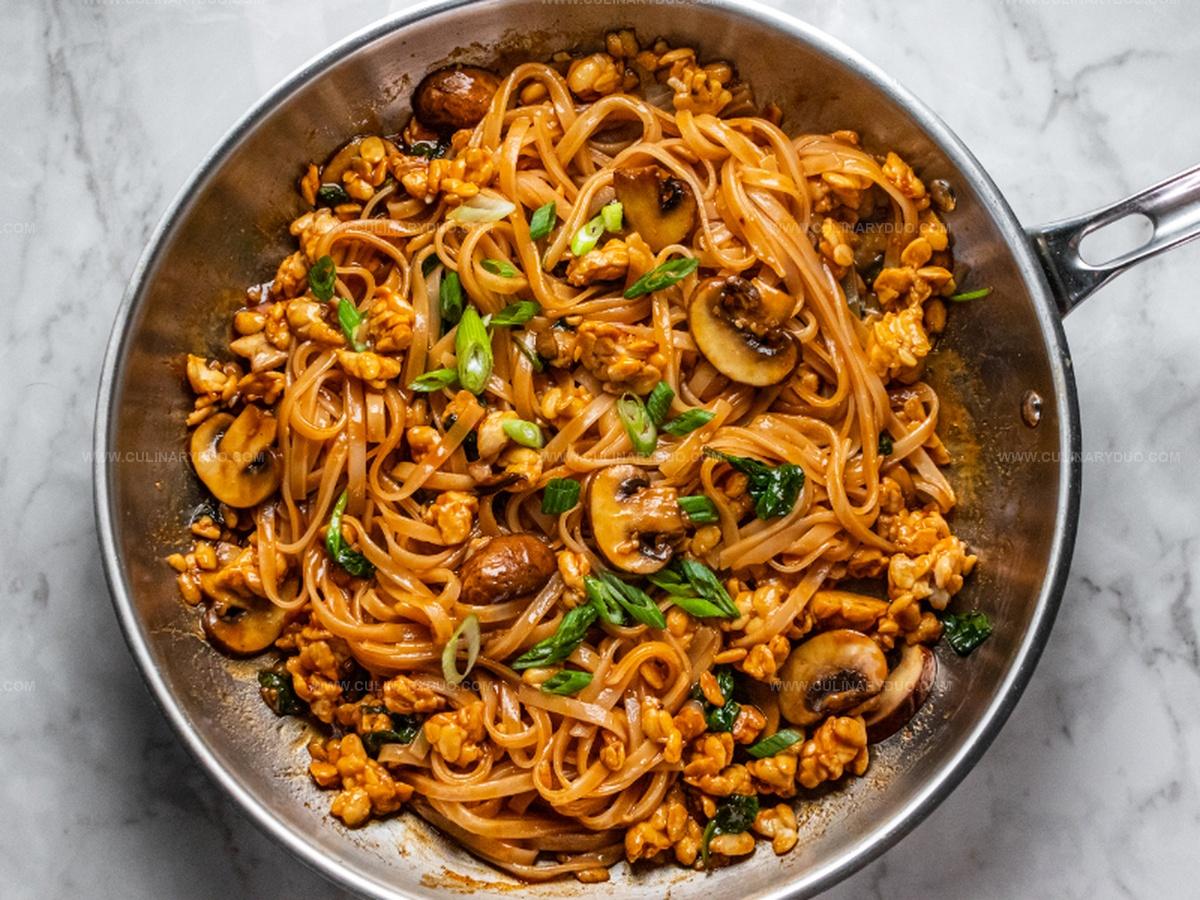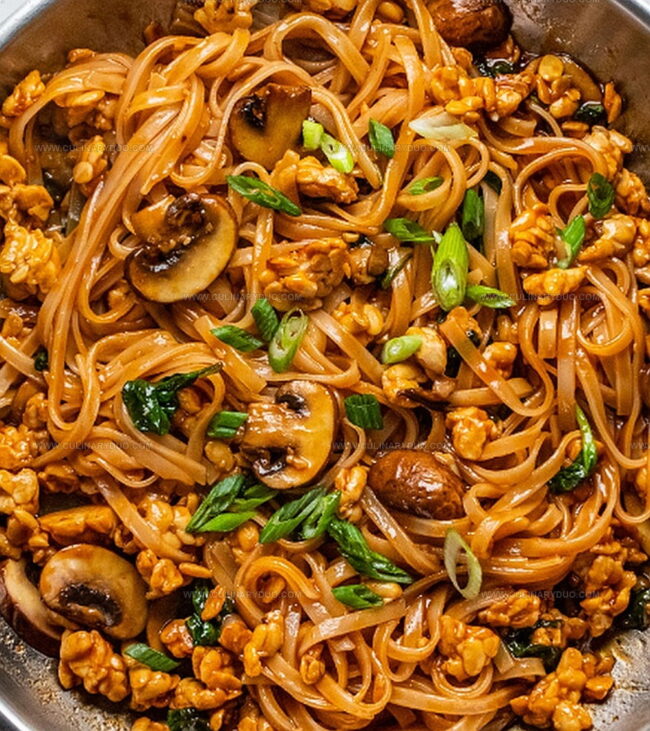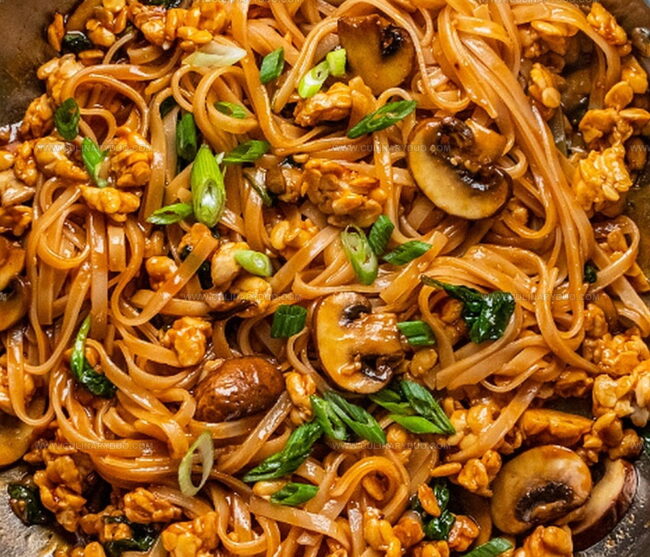Fiery Gochujang Noodles with Crumbled Tempeh Recipe
Craving something wickedly delicious, these gochujang noodles with crumbled tempeh will spark serious kitchen excitement.
Spicy Korean chili paste infuses each bite with bold, complex flavors.
Nutty tempeh adds incredible protein and texture to this plant-based marvel.
Umami notes dance across your palate with every twirling forkful.
Simple ingredients combine into a meal that feels both comforting and adventurous.
Weeknight cooking just got dramatically more interesting with this quick and satisfying dish.
Trust me – you want to whip up this game-changing recipe right now.
Gochujang Noodles with Crumbled Tempeh Highlights
Ingredients for Gochujang Noodles with Tempeh
Main Ingredients:Sauce and Seasoning:Garnish:Cooking Components:Preparation Steps for Gochujang Noodles and Tempeh
Step 1: Boil Noodles and Prepare Skillet
Drop noodles into boiling water and cook following package instructions.
Meanwhile, warm oil in a large skillet over medium heat.
Sauté mushrooms until they turn golden and release their delicious earthy aroma, which takes about 5 minutes.
Add spinach and quickly wilt for 1 minute.
Step 2: Crumble and Sizzle Tempeh
Crumble tempeh into the skillet and pour half of the spicy miso sauce over the ingredients.
Stir everything thoroughly and let it cook for 2 minutes, allowing the tempeh to absorb the vibrant flavors.
Step 3: Combine and Coat Noodles
Transfer cooked noodles into the skillet and drizzle remaining sauce.
Use tongs to toss and coat noodles completely, ensuring every strand is covered with the zesty sauce.
Plate immediately and garnish with freshly chopped green onions for a burst of brightness.
Tips for Gochujang Noodles with Tempeh
Variations for Gochujang Noodles and Tempeh
Serving Suggestions for Gochujang Tempeh Noodles
Storage Advice for Gochujang Noodles with Tempeh
FAQs
Gochujang is a Korean red chili paste that adds a spicy, sweet, and umami depth to the noodles, creating a complex and rich taste profile that makes the dish uniquely vibrant and exciting.
Tempeh is an excellent plant-based protein option that provides a firm, meaty texture and absorbs flavors well, making it a nutritious and satisfying alternative to animal proteins in this recipe.
Yes, you can easily make this recipe gluten-free by using gluten-free noodles and ensuring your gochujang and miso sauce are certified gluten-free, which are typically available in most health food stores.
Print
Gochujang Noodles with Crumbled Tempeh Recipe
- Total Time: 25 minutes
- Yield: 4 1x
Description
Spicy Korean-inspired gochujang noodles dance with crumbled tempeh, creating a bold fusion of umami and heat. Comforting noodles provide a perfect canvas for fiery sauce, inviting you to savor each complex, satisfying bite.
Ingredients
Protein:
- 8 ounces (226 grams) tempeh (crumbled)
Vegetables:
- 1 cup (150 grams) cremini mushrooms (sliced)
- 2 cups (60 grams) spinach
Noodles and Seasonings:
- 8 ounces (226 grams) rice noodles
- 2 tablespoons (30 milliliters) vegetable oil
- 2/3 cup (160 milliliters) Kikkoman® Teriyaki Takumi (Gochujang Spicy Miso Sauce)
- 2 tablespoons (6 grams) green onion (chopped)
Instructions
- Bring a pot of water to a rolling boil and prepare noodles according to package instructions until perfectly al dente, then drain and set aside.
- Heat olive oil in a spacious skillet over medium-high temperature, allowing the pan to warm evenly.
- Sauté sliced mushrooms in the hot skillet, stirring occasionally, until they release moisture and develop a golden-brown color, approximately 4-5 minutes.
- Introduce fresh spinach leaves into the skillet, quickly wilting them until they become vibrant and tender, about 45-60 seconds.
- Crumble tempeh into the vegetable mixture, breaking it into small, irregular pieces that will absorb maximum flavor.
- Pour half of the spicy miso sauce over the tempeh and vegetable blend, stirring thoroughly to ensure even coating and allowing the mixture to simmer for 2 minutes.
- Add the cooked noodles directly into the skillet, drizzling the remaining sauce and using tongs to gently toss and integrate all components until noodles are completely glazed.
- Transfer the aromatic noodle dish to serving plates, garnishing generously with finely chopped green onions for a fresh, zesty finish.
- Serve immediately while piping hot, ensuring optimal texture and flavor preservation.
Notes
- Boost protein by using extra firm tofu instead of tempeh for a softer texture and mild flavor.
- Create a gluten-free version by selecting rice noodles or 100% buckwheat soba noodles to replace traditional wheat noodles.
- Dial down heat intensity by reducing gochujang amount or substituting with mild chili paste for sensitive palates.
- Enhance nutritional profile by adding roasted sesame seeds or crushed peanuts for extra crunch and healthy fats.
- Prep Time: 10 minutes
- Cook Time: 15 minutes
- Category: Lunch, Dinner, Snacks
- Method: Sautéing
- Cuisine: Korean
Nutrition
- Serving Size: 4
- Calories: 355 kcal
- Sugar: 5 g
- Sodium: 620 mg
- Fat: 14 g
- Saturated Fat: 2 g
- Unsaturated Fat: 11 g
- Trans Fat: 0 g
- Carbohydrates: 42 g
- Fiber: 4 g
- Protein: 18 g
- Cholesterol: 0 mg




Natalie Brooks
Co-Founder & Content Strategist
Expertise
Education
eCornell
Natalie brings the vibrant, plant-powered side to Culinary Duo. After earning her Plant-Based Nutrition Certificate from eCornell, she combined her love for fresh ingredients with a passion for storytelling, aiming to make healthy cooking simple and satisfying.
Her kitchen motto: good food doesn’t need a fancy label, it just needs fresh ideas and a little creativity. Outside of writing and recipe testing, Natalie’s happiest in her garden, exploring farmers’ markets, or mixing global flavors into new kitchen experiments.